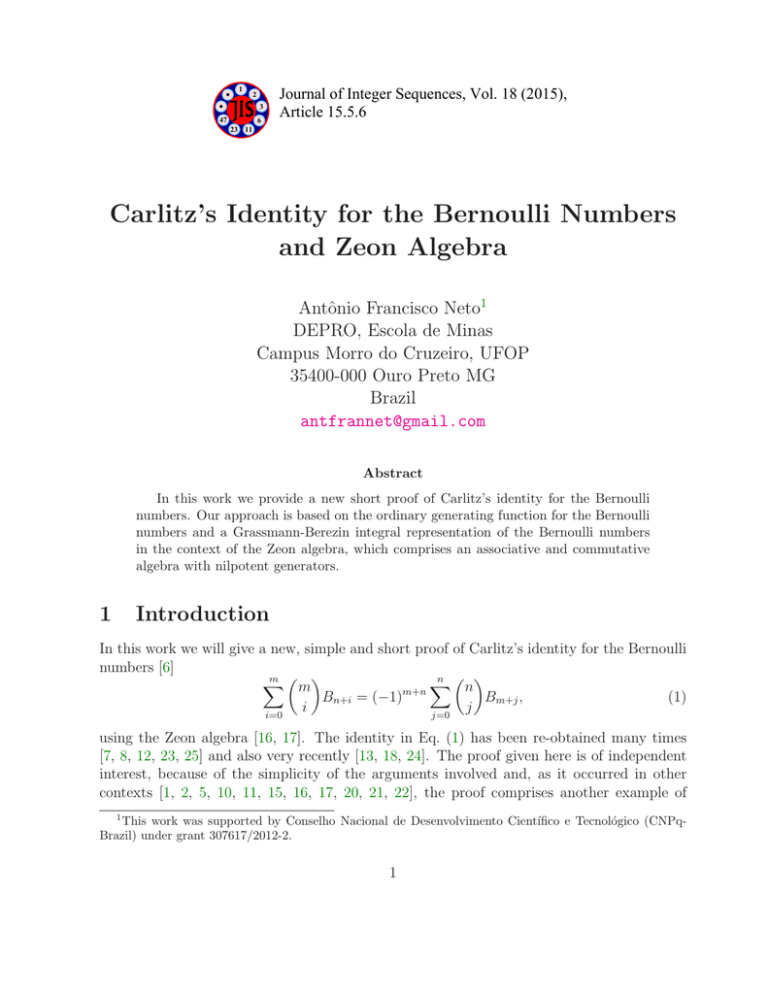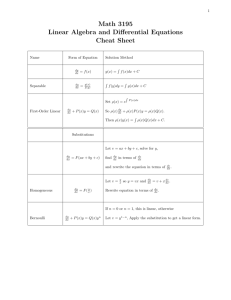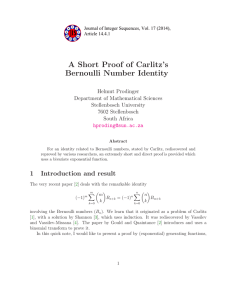Carlitz’s Identity for the Bernoulli Numbers and Zeon Algebra o
advertisement

1
2
3
47
6
Journal of Integer Sequences, Vol. 18 (2015),
Article 15.5.6
23 11
Carlitz’s Identity for the Bernoulli Numbers
and Zeon Algebra
Antônio Francisco Neto1
DEPRO, Escola de Minas
Campus Morro do Cruzeiro, UFOP
35400-000 Ouro Preto MG
Brazil
antfrannet@gmail.com
Abstract
In this work we provide a new short proof of Carlitz’s identity for the Bernoulli
numbers. Our approach is based on the ordinary generating function for the Bernoulli
numbers and a Grassmann-Berezin integral representation of the Bernoulli numbers
in the context of the Zeon algebra, which comprises an associative and commutative
algebra with nilpotent generators.
1
Introduction
In this work we will give a new, simple and short proof of Carlitz’s identity for the Bernoulli
numbers [6]
m n X
X
m
n
m+n
Bn+i = (−1)
Bm+j ,
(1)
i
j
i=0
j=0
using the Zeon algebra [16, 17]. The identity in Eq. (1) has been re-obtained many times
[7, 8, 12, 23, 25] and also very recently [13, 18, 24]. The proof given here is of independent
interest, because of the simplicity of the arguments involved and, as it occurred in other
contexts [1, 2, 5, 10, 11, 15, 16, 17, 20, 21, 22], the proof comprises another example of
1
This work was supported by Conselho Nacional de Desenvolvimento Cientı́fico e Tecnológico (CNPqBrazil) under grant 307617/2012-2.
1
the usefulness of using the Zeon algebra and/or the Grassmann algebra towards obtaining
combinatorial identities.
Before we continue, we establish the basic underlying algebraic setup needed to give the
proof of Eq. (1). Throughout this work we let Q and R denote the rational and real numbers,
respectively.
2
Basic definitions: Zeon algebra and the GrassmannBerezin integral
Definition 1. The Zeon algebra Zn ⊃ R is defined as the associative algebra generated by
the collection {εi }ni=1 (n < ∞) and the scalar 1 ∈ R, such that 1εi = εi = εi 1, εi εj = εj εi ∀
i, j and ε2i = 0 ∀ i.
Note that only linear elements in Zn contribute to the calculations.
For {i, j, . . . , k} ⊂ {1, 2, . . . , n} and εij···k ≡ εi εj · · · εk the most general element with n
generators εi can be written as (with the convention of sum over repeated indices implicit)
X
ai ε i ,
(2)
φn = a + ai εi + aij εij + · · · + a12···n ε12···n =
i∈2[n]
with a, ai , aij , . . ., a12···n ∈ R, 2[n] being the power set of [n] := {1, 2, . . . , n}, and 1 ≤ i <
j < · · · ≤ n. We refer to a as the body of φn and write b(φn ) = a and to φn − a as the soul
such that s(φn ) = φn − a.
R
Definition
2.
The
Grassmann-Berezin
integral
on
Z
,
denoted
by
, is the linear functional
n
R
: Zn → R such that (we use throughout this work the compact notation dµn := dεn · · · dε1 )
Z
Z
dεi dεj = dεj dεi ,
φn ε̂i dεi = 0 and φn ε̂i εi dεi = φn ε̂i ,
where φn ε̂i means any element of Zn with no dependence on εi . Multiple integrals are
iterated integrals, i.e.,
Z Z
Z
Z
f (φn )dµn = · · ·
f (φn )dεn dεn−1 · · · dε1 .
For example, if we define ϕn := ε1 + · · · + εn it follows directly from Definition 2 and the
multinomial theorem that
Z
ϕin dµn = i!δi,n ,
(3)
where δi,n is the Kronecker delta. For more details on Grassmann-Berezin integration, we
refer the reader to the books of Berezin [3, Chapter 1] and [4, Chapter 2] or the books of
DeWitt [9, Chapter 1] and Rogers [19, Chapter 11].
2
We will now recall some basic facts about the Zeon algebra. First, a + φn with s(a) =
0 = b(φn ) is invertible iff b(a) 6= 0. More precisely, we have
n
1
φn φ2n
1
n φn
(4)
+ 2 + · · · + (−1) n .
=
1−
a + φn
a
a
a
a
Second, the following expression holds
e
ϕn
:=
∞
X
ϕi
n
i=0
i!
=
n
X
ϕi
n
i=0
=1+
i!
X
X
εi +
1≤i≤n
εij + · · · + ε12···n .
(5)
1≤i<j≤n
= 0 ∀ n ≥ 1. Third, let
To obtain Eq. (5) we have used the multinomial theorem and ϕn+1
n
φn (ε̂i , ε̂j , . . . , ε̂k ) and dµn (ε̂i , ε̂j , . . . , ε̂k ) mean φn with εi = εj = · · · = εk = 0 and dµn with
dεi , dεj , . . . , dεk omitted, respectively. We have
Z
Z
Z
φn εij···k dµn = φn (ε̂i , ε̂j , . . . , ε̂k ) εij···k dµn = φn (ε̂i , ε̂j , . . . , ε̂k ) dµn (ε̂i , ε̂j , . . . , ε̂k ) . (6)
Eq. (6) follows directly from the general expression in Eq. (2) and Definition 2. Finally,
from Definition 2, we conclude that the order of integration is irrelevant, i.e., a Fubini-like
theorem holds in the setting of Grassmann-Berezin integration.
We are now ready to prove Eq. (1).
3
Proof of Eq. (1)
Let us write Q[[z]] for the ring of formal power series in the variable z over Q. We recall the
generating function for the Bernoulli numbers Bj in Q[[z]] [26], i.e.,
∞
1
P∞
zi
i=0 (i+1)!
X zj
z
=
Bj
= z
e −1
j!
j=0
(7)
and, making the change z → −z in Eq. (7), we get
∞
ez
P∞
zi
i=0 (i+1)!
X (−z)j
zez
=
.
Bj
= z
e −1
j!
j=0
(8)
Following the strategy of our previous work [16, 17], we consider Eqs. (7) and (8) in the
context of the Zeon algebra with the replacement z → φk ≡ ϕk . Therefore, we get
1
ϕik
i=0 (i+1)!
Pk
k
X
ϕjk
=
Bj
j!
j=0
3
(9)
and
e ϕk
ϕik
i=0 (i+1)!
Pk
k
X
=
Bj
j=0
(−ϕk )j
,
j!
P
P
ϕik
using that ϕk+1
= 0 ∀ k ≥ 1. We observe that b( ki=0 (i+1)!
) = 1 6= 0 and, hence, ki=0
k
is invertible in Zk .
Now, integrating Eq. (9) in the Zeon algebra and using Eq. (3) we get
Z
1
ϕij
i=0 (i+1)!
Pj
dµj =
Z
j
X
Bk
k=0
k!
ϕkj dµj = Bj
(10)
ϕik
(i+1)!
(11)
∀ j ≥ 1. It is straightforward to verify that the representation in Eq. (11) is equivalent to a
well-known representation of the Bernoulli numbers [14, Theorem 3.1], i.e.,
Bn = n!
n
X
(−1)i
i=1
X
i1 ,i2 ,...,in ≥0
i1 +i2 +···+in =i
i1 +2i2 +···+nin =n
i!
1
.
i1 !i2 ! · · · in ! 2!i1 3!i2 · · · (n + 1)!in
Indeed, we have
Bn =
n
X
(−1)
i
i=1
=
n
X
(−1)i
i=1
= n!
n
X
i1 2
n
i1 +i2 +···+in =i
(−1)i
i=1
= n!
n
X
i
ϕnn
ϕn ϕ2n
dµn
+
+ ··· +
2!
3!
(n + 1)!
Z
nin
X
2
ϕin1 ϕ2i
i!
n · · · ϕn
dµn
i1 3!i2 · · · (n + 1)!in
i
!i
!
·
·
·
i
!
2!
1
2
n
,i ,...,i ≥0
Z X
i!
δn,i1 +2i2 +···+nin
i
1
i1 !i2 ! · · · in ! 2! 3!i2 · · · (n + 1)!in
X
δn,i1 +2i2 +···+nin
i!
,
i
1
i1 !i2 ! · · · in ! 2! 3!i2 · · · (n + 1)!in
i1 ,i2 ,...,in ≥0
i1 +i2 +···+in =i
(−1)i
i=1
i1 ,i2 ,...,in ≥0
i1 +i2 +···+in =i
using Eqs. (3), (4) and the multinomial theorem.
By considering Eq. (10), we take k = m + n and write ϕm+n = ϕm + φn with ϕm :=
ε1 + · · · + εm , φn := ǫ1 + · · · + ǫn , and ǫi := εi+m ∀ 1 ≤ i ≤ n. Next, we multiply both sides
of Eq. (10) by e−φn . Finally, integrating the resulting equation with dµm := dεm · · · dε1 and
dνn := dǫn · · · dǫ1 we get
!
Z Z
m+n
X Bj Z Z
e ϕm
j −φn
(−ϕm − φn ) e dνn dµm .
(12)
Pm+n (ϕm +φn )i dµm dνn =
j!
j=0
i=0
(i+1)!
4
In Eq. (12) we have used a Fubini-like argument to perform the integrations. We first consider
the left-hand side of Eq. (12). By expanding eϕm as in Eq. (5) and integrating with respect
to dµm we will need to analyze terms such as
!
Z Z
X
εi1 i2 ···ij
Pm+n (ϕm +φn )i dµm dνn
1≤i1 <i2 <···<ij ≤m
i=0
(i+1)!
Z Z
1
m
dνn = m Bn+m−j .
P
dµ
=
m−j
i
m−j+n (ϕm−j +φn )
j
j
i=0
(13)
(i+1)!
Therefore, using Eq. (13), we get for the left-hand side of Eq. (12)
m X
m
i=0
i
Bn+i .
(14)
Similarly, we expand e−φn as in Eq. (5) and integrate with respect to dνn to obtain for the
right-hand side of Eq. (12)
n X
n
m+n
(−1)
Bm+j .
(15)
j
j=0
By equating the expressions in (14) and (15) we obtain the desired result, i.e., Eq. (1).
(j)
Let Bi be the i-th Bernoulli number of order j with generating function in Q[[z]] given
by
j X
∞
i
z
(j) z
=
.
B
i
ez − 1
i!
i=0
(1)
Note that Bn ≡ Bn . Following the procedure just described, it is straightforward to prove
an analogous identity for the Bernoulli numbers of higher order, i.e.,
n
m
X
X
(k)
(k)
m+n
j n
i m
Bm+j .
Bn+i = (−1)
k
k
j
i
j=0
i=0
4
Acknowledgments
The author thanks the anonymous referee for suggestions that improved the paper.
References
[1] A. Abdesselam, The Grassmann-Berezin calculus and theorems of the matrix-tree type,
Adv. in Appl. Math. 33 (2004), 51–70.
5
[2] A. Bedini, S. Caracciolo, and A. Sportiello, Hyperforests on the complete hypergraph
by Grassmann integral representation, J. Phys. A 41 (2008), 205003.
[3] F. A. Berezin, The Method of Second Quantization, Academic Press, 1966.
[4] F. A. Berezin, Introduction to Superanalysis, Reidel Publishing Company, 1987.
[5] S. Caracciolo, A. D. Sokal, and A. Sportiello, Algebraic/combinatorial proofs of Cayleytype identities for derivatives of determinants and pfaffians, Adv. in Appl. Math. 50
(2013), 474–594.
[6] L. Carlitz, Problem 795, Math. Mag. 44 (1971), 107.
[7] W. Y. C. Chen and L. H. Sun, Extended Zeilberger’s algorithm for identities on Bernoulli
and Euler polynomials, J. Number Theory 129 (2009), 2111–2132.
[8] W. Chu and P. Magli, Summation formulae on reciprocal sequences, European J. Combin. 28 (2007), 921–930.
[9] B. DeWitt, Supermanifolds, Cambridge University Press, 1992.
[10] P. Feinsilver, Zeon algebra, Fock space, and Markov chains, Commun. Stoch. Anal. 2
(2008), 263–275.
[11] P. Feinsilver and J. McSorley, Zeons, permanents, the Johnson scheme, and generalized
derangements, Int. J. Comb. (2011), Article ID 539030.
[12] I. M. Gessel, Applications of the classical umbra calculus, Algebra Universalis 49 (2003),
397–434.
[13] H. W. Gould and J. Quaintance, Bernoulli numbers and a new binomial transform
identity, J. Integer Sequences 17 (2014), Article 14.2.2.
[14] S. Jeong, M.-S. Kim, and J.-W. Son, On explicit formulae for Bernoulli numbers and
their counterparts in positive characteristic, J. Number Theory 113 (2005), 53–68.
[15] T. Mansour and M. Schork, On linear differential equations involving a para-Grassmann
variable, SIGMA Symmetry Integrability Geom. Methods Appl. 5 (2009), 073.
[16] A. F. Neto and P. H. R. dos Anjos, Zeon algebra and combinatorial identities, SIAM
Rev. 56 (2014), 353–370.
[17] A. F. Neto, Higher order derivatives of trigonometric functions, Stirling numbers of the
second kind, and zeon algebra, J. Integer Sequences 17 (2014), Article 14.9.3.
[18] H. Prodinger, A short proof of Carlitz’s Bernoulli number identity, J. Integer Sequences
17 (2014), Article 14.4.1.
6
[19] A. Rogers, Supermanifolds: Theory and Applications, World Scientific Publishing, 2007.
[20] M. Schork, Some algebraical, combinatorial and analytical properties of paraGrassmann variables, Internat. J. Modern Phys. A 20 (2005), 4797–4819.
[21] R. Schott and G. S. Staples, Partitions and Clifford algebras, European J. Combin. 29
(2008), 1133–1138.
[22] R. Schott and G. S. Staples, Zeons, lattices of partitions, and free probability, Commun.
Stoch. Anal. 4 (2010), 311–334.
[23] A. G. Shannon, Solution of problem 795, Math. Mag. 45 (1972), 55–56.
[24] J. Singh, On an arithmetic convolution, J. Integer Sequences 17 (2014), Article 14.6.7.
[25] P. Vassilev and M. Vassilev–Missana, On one remarkable identity involving Bernoulli
numbers, Notes on Number Theory and Discrete Mathematics 11 (2005), 22–24.
[26] H. S. Wilf, Generatingfunctionology, Academic Press, New York, 1990. Free download
available from http://www.math.upenn.edu/~wilf/DownldGF.html.
2010 Mathematics Subject Classification: Primary 11B68; Secondary 33B10, 05A15, 05A19.
Keywords: Zeon algebra, Berezin integration, Bernoulli number, generating function.
(Concerned with sequences A027641 and A027642.)
Received January 29 2015; revised version received April 6 2015. Published in Journal of
Integer Sequences, May 25 2015.
Return to Journal of Integer Sequences home page.
7



